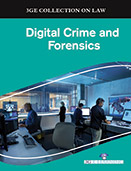Law

These days, prompt evolution of computers and mobile phones has initiated these devices to be used in criminal activities. Providing appropriate and sufficient security measures is a difficult task in order to convolution of devices which makes inspecting crimes with these devices even harder. Digital forensic is the procedure of investigating computer crimes in the cyber world. There is a growing concern that the technology, processes, and procedures used in digital investigations are not keeping abreast with the technology that criminals are using to perpetrate crime. This is generally due to a continual growth in cybercrime, increasing magnitudes of storage, a multitude of data evidence sources and continual increases in computational power.
“Digital Crime and Forensics” addresses law enforcement, detailing legal and technical procedures involved in cyberforensics employed to catch cyber-criminals. It is a guide to law and policy relating to cyber-crime, and to the limits and problems inherent in this. The book also will address current trends, common vulnerabilities, and assess the impact of cyber-crime on the economy, consumer trust, and national security. The growth in cybercrime and the complexities of the types of the cybercrime coupled with the limitations in time and resources, both computational and human, in addressing cybercrime put an increasing strain on the ability of digital investigators to apply the processes of digital forensics and digital investigations to obtain timely results. In order to combat the problems, there is a need to enhance the use of the resources available and move beyond the capabilities and constraints of the forensic tools that are in current use. This book focuses on that more intelligent techniques are necessary and should be used proactively, providing the introductory materials that students require develop these skills. It will assist readers master the forensic analysis of computer systems covering tools and technology.